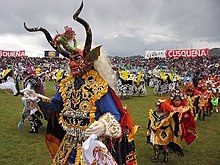| Revision as of 09:39, 27 September 2009 edit131.178.240.141 (talk)No edit summary← Previous edit | Revision as of 09:47, 27 September 2009 edit undo131.178.240.141 (talk)No edit summaryNext edit → | ||
| Line 16: | Line 16: | ||
| ==See also== | ==See also== | ||
| ⚫ | http://www.el-universal.com.mx/notas/620151.html | ||
| ⚫ | http://www.jornada.unam.mx/2009/08/21/index.php?section=espectaculos&article=a08n2esp | ||
| *] | *] | ||
| *] | *] | ||
| Line 26: | Line 24: | ||
| ==External links== | ==External links== | ||
| ⚫ | |||
| ⚫ | |||
| * | * | ||
Revision as of 09:47, 27 September 2009


The Diablada is a South American dance that was created in the Andean Altiplano but holds auto sacramental origins in Spain. The dance is practised throughout the Andean region, and is an important part of the cultural festivities of Bolivia. The dance stands prominent , the Carnaval de Oruro in Bolivia, and the Fiesta de la Tirana in Chile. However, the dance is also practiced in Venezuela, Ecuador and Panama.
The Diablada caused a reform in the thinking of the indigenous Altiplano cultures as missionaries from Spain, instilled the paradigm of good and evil, which is how the costumes of angels and demons became associated with the dance.
Miss universe dispute
In August 1 of 2009 Bolivian officials stated that it could present a legal appeal to the organizers of Miss Universe due to the planned use of a typical Diablada wear by the Peruvian candidate Karen Schwarz. Pablo Groux, Bolivian minister of Culture, said that any use of the wear by Scharwz in the content would be an unlawful appropriation of Bolivian heritage and have menaced to bring the case to the International Court of Justice. El Comercio, a Peruvian newspaper, have mentioned that this is not the first time the diablada wear is shown in the contest and that it was María Josefa Isensee, a Chilean, that first used it in the Miss Universe contest. Peruvian foreign minister José Antonio García Belaúnde said that since the Diablada dress is of indigenous Aymara origin it can not be considered an exclusive of any of the particular countries where the Aymara live.
Recently UNESCO has recognize and metion that the dance was registered as Bolivian many years ago.
See also
References
- Perú y Bolivia incluyen a Chile en disputa por traje de Diablada El Mercurio
- Bolivia rechaza que representante peruana en Miss Universo use traje de la "Diablada" El Mercurio
External links
This dance-related article is a stub. You can help Misplaced Pages by expanding it. |